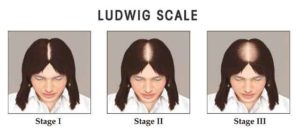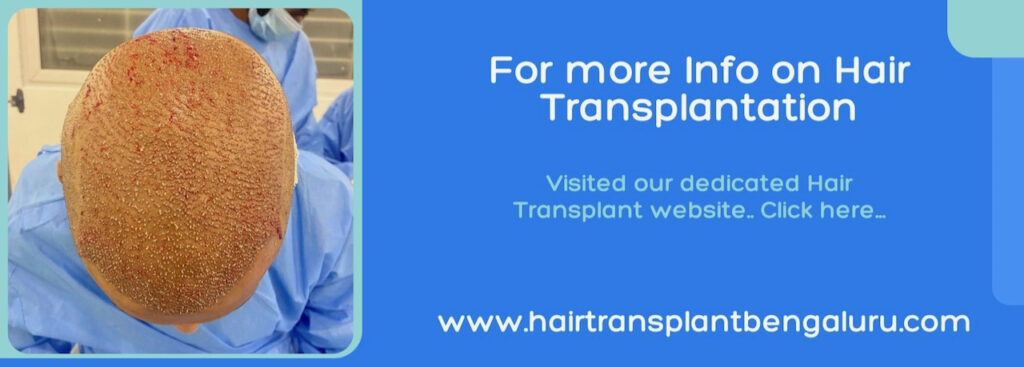Watch our Hair Transplantation Videos here...
Hair loss and hair transplantation
1. Who needs hair transplantation?
Baldness is a common problem these days. In males, it is graded into seven stages (Hamilton-Norwood Scale) depending on the extent of hair loss and into three stages in females(Ludwig). Hair loss and baldness are caused by various factors such as hormonal changes, genetics, and even environmental factors. People who suffer from hair loss or baldness look so much older and this can result in low self-esteem and depression. Also with hair transplant surgery in Bangalore, you can start to enjoy various hairstyles that show your forehead.
Male pattern Hair Loss- Seven Stages
Female Pattern Hair Loss- Three Stages
2. What are the options in hair transplantation?
There are two types of hair transplant surgeries: hair restoration surgery and hairline correction surgery. Hair restoration surgery addresses hair loss, while hairline correction surgery is for individuals wanting to change their hairline. Although both surgeries demand expertise, the design process differs between the two.
3. What are the types of hair transplantation?
hair transplant surgery in Bangalore is one of the commonly performed cosmetic procedures. Generally there are two well accepted methods of transplantation, FUT (Strip) method and FUE (Follicular unit extraction). Both these methods have their pros and cons.
The choice of either procedure depends on various factors including density, scarring tendency and extent of baldness. Both the procedures are done on daycare basis under local anesthesia. The procedure can last up to 8-10hrs depending on the individual client.
Facts and Myths about Hair Transplantation
Myth 1: Hair Transplantation results in a head full of hair
Fact: Hair transplantation redistributes existing scalp hair to improve the frontal hairline, aiming to create a more youthful look by minimizing baldness. While it can significantly enhance the appearance of thinning hair, achieving a completely full head of hair, as often depicted in advertisements, is unrealistic. A more realistic expectation is a youthful appearance with less noticeable baldness.
Myth 2: Hair transplantation can be done at any age
Fact: The transplantation is ideally done after hair fall stabilizes The exact age of the plateau is hard to define. It usually is around 25-35 years of age. In rare cases, transplantation is done at earlier stages due to social concern or extreme baldness. In case the hair fall continues even after transplantation, it can be managed with medical treatment or rarely with repeat transplantation.
Myth 3: FUE (unit extraction) method of Hair transplantation is superior to FUT (strip method) method
Fact: Hair transplantation is generally done by either FUT or FUE methods.
In FUT method a strip of scalp is removed, cut into small unites of hair and then transplanted into bald area. This leaves a long scar in the occipital areas (Back side of scalp) which may be visible if the whole head is shaved.
The FUE method involves extracting individual hair follicles and transplanting them into the bald area. This results in small, dot-like scars at the extraction site, which are much less noticeable even if the entire head is shaved. Both methods can achieve comparable results; FUE is particularly advantageous due to its minimal scarring compared to other methods.
Myth 4: Hair transplantation can be scarless
Fact: No transplantation procedure can completely avoid scarring. The FUE method minimizes scarring to tiny dots, which are less conspicuous even when the head is fully shaved. Nonetheless, some minimal scarring should still be expected.
Myth 5: Hair transplantation in ladies does not yield good results
Fact: When chosen carefully, women experiencing hair loss can achieve equally positive results. Assessing baldness in females requires a more comprehensive evaluation compared to males.
Myth 6: Laser hair transplant is now the best option available.
Fact: Laser hair transplantation is currently receiving exaggerated attention. Despite its perception as a new procedure, it has been in practice for many years. There’s a common misconception that using lasers enhances transplantation results. However, lasers play a minimal role in the overall procedure, and therefore, the final results are comparable or even better with conventional methods.
Myth 7: After hair transplantation hair starts growing immediately.
Fact: After transplantation most of the external hair falls over three weeks. The roots however continue to grow. To see the final results of transplantation, it may take anywhere between 4-8 months. Patience hence is important.
Myth 8: Transplanted hair requires life long care.
Fact: Once the initial period after hair transplanted is over, the hair can be treated normally, be it combing, coloring, hair-styling etc.
Myth 9: After transplantation, the hair should not be washed.
Fact: One or two days after transplantation the head can be shampooed normally. It is very important to keep the area clean to avoid infection. Regular care with shampoo bath is the best method.
Myth 10: hair transplant surgery in Bangalore is a very painful procedure.
Fact: Hair transplantation worldwide is typically performed under local anesthesia. The targeted area is numbed using different anesthetic creams and injections, which most patients find tolerable in terms of discomfort. Some facilities also offer monitored sedative injections during the procedure for additional comfort.
Hair Density
A major factor in achieving a natural look and the best hair transplant is determined by hair density. Hair density is measured in follicular units per square centimeter and it varies according to individual and by race. Normally the highest hair density ranges between between 70 and 120 follicular units per square centimeter.
Key to achieving density that is aesthetically pleasing is the ability to place follicular units close together. Specific cutting devices and blades that allow each follicular unit transplant site to be customized for size, depth and angle are used for the purpose. Doing this allows for dense packing with the highest level of follicular unit transplant survival.
While it is generally acknowledged that achieving a hair density that is 50% of the scalp’s original density will lead to pleasing results, it depends on other factors. These include race, skin and hair color as well as original density. For some patients, a natural look of density may occur at 30 follicles per square centimeters. For others it can be as high as 50 follicles per square centimeter. The transplantation techniques used allow for density as high as needed—limited only by the size of the donor area.
Care after Hair Transplantation
“Hair growth is a gradual process”. The statement remains true post-transplant as well..
The first weeks
Because hair loss restoration is surgery, 10% of patients can expect some mild swelling at the transplant site for the first few days. Patients can also expect to see very small crusts form at each follicular graft site. These normally slough off by the end of the first week. Any skin redness is usually gone by the first week and the scalp remains slightly pink for another few weeks.
If the patient has received a follicular unit transplant, the sutures at the donor site are removed at about 10 to 14 days. At about three weeks it is perfectly normal to be shedding hairs from the transplant follicular units. This is because the follicular units become temporarily dormant after any transplant procedure.
The first months
When the dormant period ends, hair loss restoration patients can expect to see some new hairs sprouting from the transplant area of the scalp. The time when this begins to occur varies greatly among patients. But, the average time is around three months. Over time, more and more hairs will sprout and they will be very thin at first and then grow thicker over time.
Six months to one year
By six months, the average patient is likely to see considerable new hair growth with about half the new hairs visible above the scalp. At six months about half the hair will be visible above the scalp. At nine months 75% of the hair will be visible. And from 10-12 months patients can expect to see the final results of their procedure. The transplanted hair will continue to grow for the rest of the patient’s life. There is no need for special care or new visits to the doctor.
Contura Clinic undertakes best hair transplant surgery in Bangalore
Dr. Sreekar is one of the best hair transplant specialists in Bangalore
Read more about Hair Transplantation in Bangalore:


